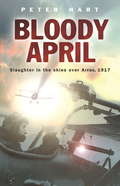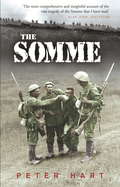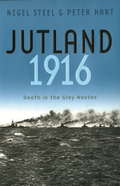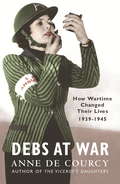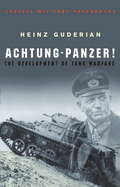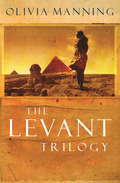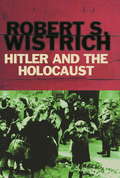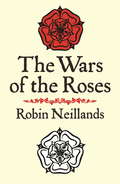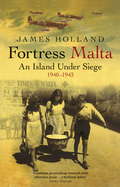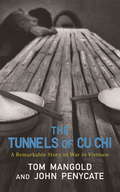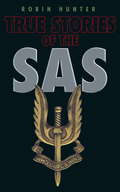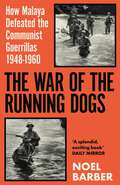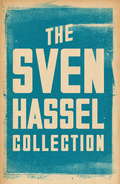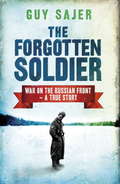- Table View
- List View
Bloody April: Slaughter In The Skies Over Arras, 1917
by Peter HartThe story of the decimation of the Royal Flying Corps over Arras in 1917As the Allies embarked upon the Battle of Arras, they desperately needed accurate aerial reconnaissance photographs. But by this point the Royal Flying Club were flying obsolete planes. The new German Albatros scouts massively outclassed them in every respect: speed, armament, ability to withstand punishment and manoeuverability. Many of the RFC's pilots were straight out of flying school - as they took to the air they were sitting targets for the experienced German aces. Over the course of 'Bloody April' the RFC suffered casualties of over a third. The average life expectancy of a new subaltern on the front line dropped to just eleven days. And yet they carried on flying, day after day, in the knowledge that, in the eyes of their commanders at least, their own lives meant nothing compared to the photographs they brought back, which could save tens of thousands of soldiers on the ground. In this book Peter Hart tells the story of the air war over Arras, using the voices of the men who were actually there.
Bloody April: Slaughter in the Skies over Arras, 1917
by Peter HartThe story of the decimation of the Royal Flying Corps over Arras in 1917As the Allies embarked upon the Battle of Arras, they desperately needed accurate aerial reconnaissance photographs. But by this point the Royal Flying Club were flying obsolete planes. The new German Albatros scouts massively outclassed them in every respect: speed, armament, ability to withstand punishment and manoeuverability. Many of the RFC's pilots were straight out of flying school - as they took to the air they were sitting targets for the experienced German aces. Over the course of 'Bloody April' the RFC suffered casualties of over a third. The average life expectancy of a new subaltern on the front line dropped to just eleven days. And yet they carried on flying, day after day, in the knowledge that, in the eyes of their commanders at least, their own lives meant nothing compared to the photographs they brought back, which could save tens of thousands of soldiers on the ground. In this book Peter Hart tells the story of the air war over Arras, using the voices of the men who were actually there.
The Somme: The Darkest Hour On The Western Front
by Peter Hart Nigel SteelA major new history of the most infamous battle of the First World War, as described by the men who fought it. On 1 July 1916, Douglas Haig's army launched the 'Big Push' that was supposed finally to bring an end to the stalemate on the Western Front. What happened next was a human catastrophe: scrambling over the top into the face of the German machine guns and artillery fire, almost 20,000 British and Commonwealth soldiers were killed that day alone, and twice as many wounded - the greatest loss in a single day ever sustained by the British Army. The battle did not stop there, however. It dragged on for another 4 months, leaving the battlefield strewn with literally hundreds of thousands of bodies. The Somme has remained a byword for the futility of war ever since. In this major new history, Peter Hart describes how the battle looked from the point of view of those who fought it. Using never-before-seen eyewitness testimonies, he shows us this epic conflict from all angles. We see what it was like to crawl across No Man's Land in the face of the German guns, what it was like for those who stayed behind in the trenches - the padres, the artillerymen, the doctors. We also see what the battle looked like from the air, as the RFC battled to keep control of the skies above the battlefield. All this is put in the context of the background to the battle, and Haig's overall strategy for the Western Front, making this the most comprehensive history of the battle since Lyn MacDonald's bestselling work over 20 years ago.
The Somme
by Peter Hart Nigel SteelA major new history of the most infamous battle of the First World War, as described by the men who fought it.On 1 July 1916, Douglas Haig's army launched the 'Big Push' that was supposed finally to bring an end to the stalemate on the Western Front. What happened next was a human catastrophe: scrambling over the top into the face of the German machine guns and artillery fire, almost 20,000 British and Commonwealth soldiers were killed that day alone, and twice as many wounded - the greatest loss in a single day ever sustained by the British Army. The battle did not stop there, however. It dragged on for another 4 months, leaving the battlefield strewn with literally hundreds of thousands of bodies. The Somme has remained a byword for the futility of war ever since. In this major new history, Peter Hart describes how the battle looked from the point of view of those who fought it. Using never-before-seen eyewitness testimonies, he shows us this epic conflict from all angles. We see what it was like to crawl across No Man's Land in the face of the German guns, what it was like for those who stayed behind in the trenches - the padres, the artillerymen, the doctors. We also see what the battle looked like from the air, as the RFC battled to keep control of the skies above the battlefield. All this is put in the context of the background to the battle, and Haig's overall strategy for the Western Front, making this the most comprehensive history of the battle since Lyn MacDonald's bestselling work over 20 years ago.
Jutland, 1916: Death In The Grey Wastes (Sven Hassel War Classics)
by Peter Hart Nigel SteelDramatic, illustrated account of the biggest naval battle of the First World War.On 31 May, 1916, the great battle fleets of Britain and Germany met off Jutland in the North Sea. It was a climactic encounter, the culmination of a fantastically expensive naval race between the two countries, and expectations on both sides were high. For the Royal Navy's Grand Fleet, there was the chance to win another Trafalgar. For the German High Seas Fleet, there was the opportunity to break the British blockade and so change the course of the war. But Jutland was a confused and controversial encounter. Tactically, it was a draw; strategically, it was a British victory.Naval historians have pored over the minutiae of Jutland ever since. Yet they have largely ignored what the battle was actually like for its thousands of participants. Full of drama and pathos, of chaos and courage, JUTLAND, 1916 describes the sea battle in the dreadnought era from the point of view of those who were there.
Jutland, 1916: Death in the Grey Wastes
by Nigel Steel Peter HartDramatic, illustrated account of the biggest naval battle of the First World War.On 31 May, 1916, the great battle fleets of Britain and Germany met off Jutland in the North Sea. It was a climactic encounter, the culmination of a fantastically expensive naval race between the two countries, and expectations on both sides were high. For the Royal Navy's Grand Fleet, there was the chance to win another Trafalgar. For the German High Seas Fleet, there was the opportunity to break the British blockade and so change the course of the war. But Jutland was a confused and controversial encounter. Tactically, it was a draw; strategically, it was a British victory.Naval historians have pored over the minutiae of Jutland ever since. Yet they have largely ignored what the battle was actually like for its thousands of participants. Full of drama and pathos, of chaos and courage, JUTLAND, 1916 describes the sea battle in the dreadnought era from the point of view of those who were there.
Debs at War: 1939-1945
by Anne de CourcyAn extraordinary account - from firsthand sources - of upper class women and the active part they took in the WarPre-war debutantes were members of the most protected, not to say isolated, stratum of 20th-century society: the young (17-20) unmarried daughters of the British upper classes. For most of them, the war changed all that for ever. It meant independence and the shock of the new, and daily exposure to customs and attitudes that must have seemed completely alien to them. For many, the almost military regime of an upper class childhood meant they were well suited for the no-nonsense approach needed in wartime. This book records the extraordinary diversity of challenges, shocks and responsibilities they faced - as chauffeurs, couriers, ambulance-drivers, nurses, pilots, spies, decoders, factory workers, farmers, land girls, as well as in the Women's Services. How much did class barriers really come down? Did they stick with their own sort? And what about fun and love in wartime - did love cross the class barriers?
Debs at War: 1939-1945 (WOMEN IN HISTORY)
by Anne de CourcyAn extraordinary account - from firsthand sources - of upper class women and the active part they took in the WarPre-war debutantes were members of the most protected, not to say isolated, stratum of 20th-century society: the young (17-20) unmarried daughters of the British upper classes. For most of them, the war changed all that for ever. It meant independence and the shock of the new, and daily exposure to customs and attitudes that must have seemed completely alien to them. For many, the almost military regime of an upper class childhood meant they were well suited for the no-nonsense approach needed in wartime. This book records the extraordinary diversity of challenges, shocks and responsibilities they faced - as chauffeurs, couriers, ambulance-drivers, nurses, pilots, spies, decoders, factory workers, farmers, land girls, as well as in the Women's Services. How much did class barriers really come down? Did they stick with their own sort? And what about fun and love in wartime - did love cross the class barriers?
Achtung Panzer!
by Heinz GuderianThis is one of the most significant military books of the twentieth century. By an outstanding soldier of independent mind, it pushed forward the evolution of land warfare and was directly responsible for German armoured supremacy in the early years of the Second World War. Published in 1937, the result of 15 years of careful study since his days on the German General Staff in the First World War, Achtung Panzer! argues how vital the proper use of tanks and supporting armoured vehicles would be in the conduct of a future war. When that war came, just two years later, he proved it, leading his Panzers with distinction in the Polish, French and Russian campaigns. Panzer warfare had come of age, exactly as he had forecast.This first English translation of Heinz Guderian's classic book - used as a textbook by Panzer officers in the war - has an introduction and extensive background notes by the modern English historian Paul Harris.
Achtung Panzer! (W&N Military)
by Heinz GuderianThis is one of the most significant military books of the twentieth century. By an outstanding soldier of independent mind, it pushed forward the evolution of land warfare and was directly responsible for German armoured supremacy in the early years of the Second World War. Published in 1937, the result of 15 years of careful study since his days on the German General Staff in the First World War, Achtung Panzer! argues how vital the proper use of tanks and supporting armoured vehicles would be in the conduct of a future war. When that war came, just two years later, he proved it, leading his Panzers with distinction in the Polish, French and Russian campaigns. Panzer warfare had come of age, exactly as he had forecast.This first English translation of Heinz Guderian's classic book - used as a textbook by Panzer officers in the war - has an introduction and extensive background notes by the modern English historian Paul Harris.
The Levant Trilogy: 'Fantastically tart and readable' Sarah Waters (W&N Essentials)
by Olivia Manning'Fantastically tart and readable' Sarah Waters 'These books are clearly among the very best fiction about the Second World War. They are written with the English poise and understatement that Jane Austen raised to its highest art form' Chris Patten, The Sunday Times 'The finest fictional record of the war produced by a British writer' Anthony Burgess In the spring of 1941, a young English couple, Guy and Harriet Pringle, arrive in Egypt as Rommel's forces slowly but surely approach Cairo across the Sahara from the west. Will the city fall? In the streets the people contemplate welcoming a new set of occupiers, while European refugees and well-heeled Anglo-Egyptians prepare to pack their bags. And at night, everyone who is anyone flocks to the city's famed hotels and seedy cabarets, seeking one last dance before the tanks roll in. Manning describes the Pringles' ever complicated marriage and their motley group of friends and foes with a sharp eye. And the civilian world meets the military through the figure of Simon Boulderstone, a young army officer who will witness the tragedy and tension of war on the frontier at first hand.
The Levant Trilogy: 'Fantastically tart and readable' Sarah Waters (W&N Essentials)
by Olivia ManningThe classic World War II trilogy: 'The finest fictional record of the war produced by a British writer' Anthony BurgessAs Rommel advances in wartorn Egypt, the lives of the civilian population come under threat. One such couple are Guy and Harriet Pringle, who have escaped the war in Europe only to find the conflict once more on their doorstep, providing a volatile backdrop to their own personal battles.The civilian world meets the military through the figure of Simon Boulderstone, a young army officer who will witness the tragedy and tension of war on the frontier at first hand.An outstanding author of wartime fiction, Olivia Manning brilliantly evokes here the world of the Levant - Egypt, Jerusalem and Syria - with perception and subtlety, humour and humanity.
Hitler and the Holocaust
by Prof Robert S. WistrichA superb short historical analysis of the Holocaust, by one of the world's leading authorities on the subjectRobert Wistrich begins by exploring the origins of anti-Semitism in Europe, and especially in Germany, to try to explain how millions of Jews came to be killed systematically by the Third Reich. In the process of relating these events, he provides new and incisive answers to a number of central questions concerning the Shoah that have emerged over recent years: who, inside and outside Nazi Germany, knew that Jews were being murdered; how responsibility for the genocide should be divided between Hitler himself and ordinary Germans; and how historians have tried to make sense of the Holocaust.The book concludes by considering the legacy of Nazi crimes since 1945: the Nuremburg trials, the impact of the Holocaust on Diaspora Jewry (particularly in Israel and America), and the rise of neo-Nazism and Holocaust-denial.
The Wars of the Roses
by Robin NeillandsA concise and entertaining study of the vicious wars between the English noble houses of York and Lancaster during the 15th century.The vicious wars between the English noble houses of York and Lancaster marked the end of medieval England and the birth of the Renaissance. The end of that thirty-year period of strife and bloodshed saw the collapse of the great Plantagenet dynasty, rulers of all England and much of France for over three hundred years, and the rise of the Tudors. All the characters are here: Henry V and his luckless son, Henry VI, together with his unfortunate uncles, John of Bedford and Humphrey of Gloucester, not to mention the notorious Richard III and his nephews - The Princes in the Tower. Neillands skilfully tackles this complex period providing a clear and entertaining analysis.
The Wars of the Roses
by Robin NeillandsA concise and entertaining study of the vicious wars between the English noble houses of York and Lancaster during the 15th century.The vicious wars between the English noble houses of York and Lancaster marked the end of medieval England and the birth of the Renaissance. The end of that thirty-year period of strife and bloodshed saw the collapse of the great Plantagenet dynasty, rulers of all England and much of France for over three hundred years, and the rise of the Tudors. All the characters are here: Henry V and his luckless son, Henry VI, together with his unfortunate uncles, John of Bedford and Humphrey of Gloucester, not to mention the notorious Richard III and his nephews - The Princes in the Tower. Neillands skilfully tackles this complex period providing a clear and entertaining analysis.
Fortress Malta: An Island Under Siege 1940-1943
by James HollandThe extraordinary drama of Malta's WWII victory against impossible odds told through the eyes of the people who were there.In March and April 1942, more explosives were dropped on the tiny Mediterranean island of Malta - smaller than the Isle of Wight - than on the whole of Britain during the first year of the Blitz. Malta had become one of the most strategically important places in the world. From there, the Allies could attack Axis supply lines to North Africa; without it, Rommel would be able to march unchecked into Egypt, Suez and the Middle East. For the Allies this would have been catastrophic. As Churchill said, Malta had to be held 'at all costs'.FORTRESS MALTA follows the story through the eyes of those who were there: young men such as twenty-year-old fighter pilot Raoul Daddo-Langlois, anti-aircraft gunner Ken Griffiths, American Art Roscoe and submariner Tubby Crawford - who served on the most successful Allied submarine of the Second World War; cabaret dancer-turned RAF plotter Christina Ratcliffe, and her lover, the brilliant and irrepressible reconnaissance pilot, Adrian Warburton. Their stories and others provide extraordinary first-hand accounts of heroism, resilience, love, and loss, highlighting one of the most remarkable stories of World War II.
Fortress Malta: An Island Under Siege 1940-1943 (W&N Military)
by James HollandThe extraordinary drama of Malta's WWII victory against impossible odds told through the eyes of the people who were there.In March and April 1942, more explosives were dropped on the tiny Mediterranean island of Malta - smaller than the Isle of Wight - than on the whole of Britain during the first year of the Blitz. Malta had become one of the most strategically important places in the world. From there, the Allies could attack Axis supply lines to North Africa; without it, Rommel would be able to march unchecked into Egypt, Suez and the Middle East. For the Allies this would have been catastrophic. As Churchill said, Malta had to be held 'at all costs'.FORTRESS MALTA follows the story through the eyes of those who were there: young men such as twenty-year-old fighter pilot Raoul Daddo-Langlois, anti-aircraft gunner Ken Griffiths, American Art Roscoe and submariner Tubby Crawford - who served on the most successful Allied submarine of the Second World War; cabaret dancer-turned RAF plotter Christina Ratcliffe, and her lover, the brilliant and irrepressible reconnaissance pilot, Adrian Warburton. Their stories and others provide extraordinary first-hand accounts of heroism, resilience, love, and loss, highlighting one of the most remarkable stories of World War II.
The Tunnels of Cu Chi: A Remarkable Story of War
by Tom Mangold John PenycateThe story of an extraordinary campaign in the Vietnam War - fought in a 200-mile labyrinth of underground tunnels and chambers.The campaign in the tunnels of Cu Chi was fought with cunning and savagery between Viet Cong guerrillas and special teams of US infantrymen called 'Tunnel Rats'. The location: the 200-mile labyrinth of underground tunnels and secret chambers that the Viet Cong had dug around Saigon.The Tunnel Rats were GIs of legendary skill and courage. Armed only with knives and pistols, they fought hand-to-hand against a cruel and ingenious enemy inside the booby-trapped blackness of the tunnels. For the Viet Cong the tunnel network became their battlefield, their barracks, their arms factories and their hospitals, as the ground above was pounded to dust by American shells and bombs.
True Stories of the SAS
by Robin HunterThe soldiers of the SAS are among the most ruthless and efficient in the world. Their daring and determination have made Britain's top-secret military unit one of the most feared and respected special forces in existence. True Stories of the SAS is a history of the deeds done by these lethal men as they faced danger with calm courage. From the parachute raids and jeep attacks of World War II to covert activity in the Gulf War, the SAS have fought in each major conflict of the last fifty years. Their every mission is a tale of inspired strategy and decisive action, from the fight for the German-held islands of the Aegean to the struggle against the Communists in the Malayan jungle and their spectacular success at the Iranian Embassy siege in London. These astonishing stories reveal the bravery, endurance and sheer military brilliance that have made the SAS truly a force to be reckoned with.
True Stories of the SAS
by Robin HunterThe soldiers of the SAS are among the most ruthless and efficient in the world. Their daring and determination have made Britain's top-secret military unit one of the most feared and respected special forces in existence.True Stories of the SAS is a history of the deeds done by these lethal men as they faced danger with calm courage. From the parachute raids and jeep attacks of World War II to covert activity in the Gulf War, the SAS have fought in each major conflict of the last fifty years. Their every mission is a tale of inspired strategy and decisive action, from the fight for the German-held islands of the Aegean to the struggle against the Communists in the Malayan jungle and their spectacular success at the Iranian Embassy siege in London.These astonishing stories reveal the bravery, endurance and sheer military brilliance that have made the SAS truly a force to be reckoned with.
The War of the Running Dogs: How Malaya Defeated The Communist Guerrillas, 1948-1960 (Sven Hassel War Classics)
by Noel Barber'The story of the first all-out struggle in Asia between Communism and the West, vividly told in an exciting and engrossing book' Sunday ExpressOnly three short years after the end of the Japanese occupation, war came again to Malaya. The Chinese-backed guerrillas called it the War of the Running Dogs - their contemptuous term for those in Malaya who remained loyal to the British. The British Government referred to this bloody and costly struggle as the 'Malayan Emergency'. Yet it was a war that lasted twelve years and cost thousands of lives. By the time it was over Malaya had obtained its independence - but on British, not on Chinese or Communist terms. Here is the war as it was. Here are the planters and their wives on their remote rubber estates, the policemen, the generals and the soldiers, the Malays, Chinese and Indians of a polyglot country, all fighting an astute, ruthless, and well organized enemy.
The War of the Running Dogs: Malaya 1948-1960 (W&N Military)
by Noel Barber'The story of the first all-out struggle in Asia between Communism and the West, vividly told in an exciting and engrossing book' Sunday ExpressOnly three short years after the end of the Japanese occupation, war came again to Malaya. The Chinese-backed guerrillas called it the War of the Running Dogs - their contemptuous term for those in Malaya who remained loyal to the British. The British Government referred to this bloody and costly struggle as the 'Malayan Emergency'. Yet it was a war that lasted twelve years and cost thousands of lives. By the time it was over Malaya had obtained its independence - but on British, not on Chinese or Communist terms. Here is the war as it was. Here are the planters and their wives on their remote rubber estates, the policemen, the generals and the soldiers, the Malays, Chinese and Indians of a polyglot country, all fighting an astute, ruthless, and well organized enemy.
The Sven Hassel Collection
by Sven HasselFrom the fight for survival against the ferocious Red Army and the icy, shell-ravaged wastes of the vicious Russian winter, to the bloodiest battles on the Eastern Front, Sven Hassel's gripping novels are based on his own experiences in the German army. Convicted of deserting the German army, Sven Hassel was sent to a punishment regiment on the Russian Front. He and his comrades were regarded as little more than dispensable killing-machines, cannon fodder for Hitler's war. His unflinching narrative takes us to the most extreme outposts of war, where soldiers face an inferno of blood and butchery. THE SVEN HASSEL COLLECTION includes all 14 books in Sven Hassel's series and exclusive extra material.
The Sven Hassel Collection (Sven Hassel War Classics)
by Sven HasselFrom the fight for survival against the ferocious Red Army and the icy, shell-ravaged wastes of the vicious Russian winter, to the bloodiest battles on the Eastern Front, Sven Hassel's gripping novels are based on his own experiences in the German army. Convicted of deserting the German army, Sven Hassel was sent to a punishment regiment on the Russian Front. He and his comrades were regarded as little more than dispensable killing-machines, cannon fodder for Hitler's war. His unflinching narrative takes us to the most extreme outposts of war, where soldiers face an inferno of blood and butchery. THE SVEN HASSEL COLLECTION includes all 14 books in Sven Hassel's series and exclusive extra material.
The Forgotten Soldier
by Guy SajerAn international bestseller, this is a German soldier's first-hand account of life on Russian front during the second half of the Second World War.When Guy Sajer joins the infantry full of ideals in the summer of 1942, the German army is enjoying unparalleled success in Russia. However, he quickly finds that for the foot soldier the glory of military success hides a much harsher reality of hunger, fatigue and constant deprivation. Posted to the crack Grosse Deutschland division, with its sadistic instructors who shoot down those who fail to make the grade, he enters a violent and remorseless world where all youthful hope is gradually ground down, and all that matters is the brute will to survive. As the biting cold of the Russian winter sets in, and the tide begins to turn against the Germans, life becomes an endless round of pounding artillery attacks and vicious combat against a relentless and merciless Red Army. A book of stunning force, this is an unforgettable reminder of the horrors of war.
